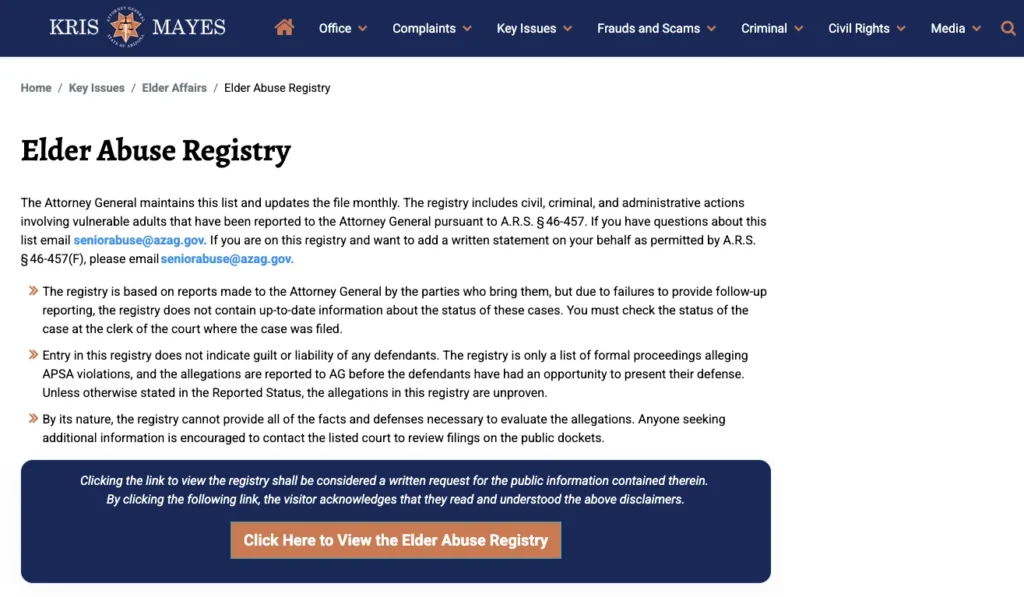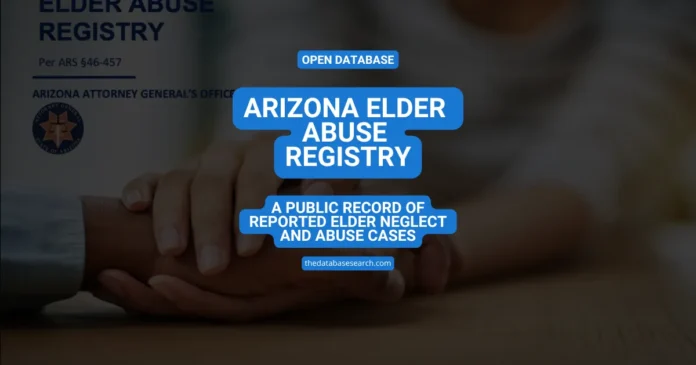When caregivers go beyond the boundaries of neglect to abuse, the consequences are not likely to be immediately obvious. Yet, each month, Arizona’s Attorney General discreetly updates one of the state’s most sobering public files – the Arizona Elder Abuse Registry – a database intended to list civil, criminal, and administrative actions regarding abuse, neglect, or exploitation of vulnerable adults.
Most Arizonans have never heard of it. However, for families who are selecting assisted-living facilities or home-care providers, the Registry can make a difference between trusting someone, and a tragic event. This article identifies what the Registry is, how it works, and equally importantly, what the limits are in the use of the registry.
What Is the Arizona Elder Abuse Registry?
The Arizona Elder Abuse Registry is a state-wide registry maintained by the Office of the Arizona Attorney General (AGO) that lists individuals and entities who have been accused of violating the Arizona Adult Protective Services Act (APSA) found at A.R.S. § 46-457.
The Arizona Elder Abuse Registry, maintained by the Office of the Arizona Attorney General (AGO), is a state-wide registry listing individuals and entities who have been accused of violating the Arizona Adult Protective Services Act (A.R.S. § 46-457).
👉 Official Access: https://www.azag.gov/issues/elder-affairs/elder-abuse-registry
Unlike most searchable databases, this one is distributed as a downloadable PDF, updated monthly. It summarizes formal proceedings — lawsuits or administrative complaints — that have been reported to the Attorney General involving elder abuse or neglect.
The registry is not a list of convictions or findings of guilt. Instead, it’s a public accountability tool, designed to alert the public that a case has been filed under APSA.
What Kind of Data Does the Arizona Elder Abuse Registry Contain?
Each monthly file includes several critical data fields that provide a concise but informative snapshot of each reported case:
- AGO Number – the Attorney General’s internal case tracking ID.
- Defendants – the individuals or organizations accused of elder abuse or neglect.
- Incident Date – when the alleged misconduct occurred.
- Synopsis of Allegation/Complaint – a brief narrative describing the nature of the abuse or neglect claim.
- Filing Date – the date the case was officially filed.
- Court and Court Case Number – where the case is being litigated.
- Reported Status – the current known status, if any has been provided.
For example, a line might read:
“AGO-23-1456 | Jane Doe | Alleged neglect in assisted living facility | Filed 08/15/2023 | Maricopa County Superior Court | Pending.”
This makes it possible for families, journalists, and advocacy organizations to trace a case’s origins and locate the relevant public court docket for further information.
Why the Arizona Elder Abuse Registry Exists
Elder abuse is becoming an important public health and legal matter in the U.S. The National Council on Aging (NCOA) reports that an estimated 1 in 10 Americans over the age of 60 will experience some form of elder abuse each year, and there is only a small percentage of abuse being reported, so the problem is likely larger.
Arizona has taken a more unique approach to this work by creating this registry established under A.R.S. § 46-457, which requires the Attorney General to maintain a list of each civil, criminal, and administrative action related to violations of APSA.
This is all about transparency — the intention is to inform the public when serious accusations have been brought, even if there is ongoing adjudication.
Important Legal Caveats
The Attorney General’s Office is clear:
“Entry in this registry does not indicate guilt or liability of any defendants.”
This is crucial. The registry merely compiles allegations, not outcomes. Because reporting parties sometimes fail to provide updates, many case statuses may remain outdated or incomplete. Users are explicitly advised to verify the case status directly with the Clerk of the Court listed in the record.
The AGO further emphasizes that:
“By its nature, the registry cannot provide all the facts and defenses necessary to evaluate the allegations.”
In other words, the database should be treated as a starting point for due diligence, not as a verdict.
How to Use the Arizona Elder Abuse Registry
The process is straightforward but requires care:
- Download the Latest PDF
Visit the Arizona Attorney General’s Elder Abuse Registry. The file is updated monthly — the date appears at the top of the document.

- Search by Name or Facility
Use the PDF search (Ctrl+F or Cmd+F) to locate the name of an individual, company, or care facility. - Note the Case Number and Court
Each record includes a court case identifier. This lets you verify details using Arizona’s Superior Court public docket systems (e.g., Maricopa County Superior Court Docket). - Verify the Case Status
Because the registry may not reflect ongoing case updates, check the court docket to confirm whether the case is pending, dismissed, or resolved. - Interpret Carefully
Remember: inclusion on the list reflects an allegation, not a conviction or legal finding.
Why This Database Matters
Arizona’s registry stands out nationally because very few states offer publicly accessible elder abuse listings. In most jurisdictions, such information is fragmented across court systems or unavailable due to privacy laws.
For families researching nursing homes, home-care providers, or assisted-living staff, this registry serves as a first line of defense.
As reported by ABC15 Arizona Investigations, resources like the Elder Abuse Registry and the AZ Care Check system can uncover hidden warning signs — such as facilities with repeated compliance violations or caregivers linked to prior neglect cases (ABC15, 2024).
By cross-referencing the registry with the Arizona Department of Health Services’ AZ Care Check and the federal Medicare Care Compare tool, families can build a more complete picture of care quality and risk factors.
Limitations and Common Misunderstandings
While the registry encourages transparency, it has structural limitations:
- No real-time updates: Many cases end with follow-up reports, and a listing may remain “pending” long after the resolution.
- Not an admission of guilt: It is a procedural inclusion—cases can be dismissed or settled later.
- Not a full database of abuse: The data is limited to formal – of which there are some, but not all – cases reported to the Adult Protective Services Act (APSA) and does not include every instance of elder abuse abuse reported to Adult Protective Services (APS).
- Format limitations: The PDF format limits the ability to order information and use an API – preventing data analysis or automated monitoring.
Data governance experts will often provide this as an example case of how public interest databases lag usability – even in transparency cases.
Practical Example: How It Helps
Consider a family vetting two assisted-living facilities in Phoenix.
Facility A has no record on AZ Care Check but appears in the Elder Abuse Registry due to a civil complaint alleging neglect in 2022.
Facility B appears clean across all databases.
Even though Facility A’s case might later be dismissed, the listing alerts the family to dig deeper — contact the court, ask for inspection histories, and verify staff credentials.
This cautious approach can prevent future harm and pressure institutions to maintain higher accountability standards.
The Bigger Picture: A Model for Other States
The Arizona Elder Abuse Registry signals an emerging trend in elder protection that is based on data. By tracking legal actions involving elder abuse in an organized and publicly accessible way, Arizona has developed a “public accountability tool” that other states can follow.
However, to reach its full potential, experts recommend:
- Converting the static PDF into a searchable online interface.
- Adding case resolution updates.
- Integrating court API links for transparency and automation.
Until then, the registry remains an invaluable — if imperfect — lens into how Arizona confronts elder abuse.
Key Takeaways
- The Arizona Elder Abuse Registry is a public monthly PDF list maintained by the Attorney General.
- It includes civil, criminal, and administrative allegations, not confirmed findings.
- Always verify case status through the Clerk of the Court.
- Use it alongside AZ Care Check and Medicare Care Compare for broader context.
- Despite limitations, it’s one of the most transparent elder-abuse resources in the United States.
Expert Sources
- Arizona Attorney General’s Office – Elder Abuse Registry
- Arizona Revised Statutes – A.R.S. § 46-457: Adult Protective Services Act (APSA)
- ABC15 Arizona – Three online databases to help you research nursing homes, assisted-living facilities (2024)
- Arizona Department of Health Services – AZ Care Check
- U.S. Centers for Medicare & Medicaid Services – Medicare’s comparison tool
- National Council on Aging (NCOA) – Elder Abuse Facts & Statistics (2023)


